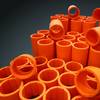Late last month the MAN Group publicly announced the availability of a new engine which fully embodies the advantages of common rail diesel technology, meaning that it is designed to be particularly reliable, clean, economic and durable. "Now this technology is where we wanted to have it," says Fritz Pape, Member of the Executive Board of MAN B&W. This in-house development combines conventional components of existing MAN injection systems with up-to-date hydraulic and electronic elements that have been developed further. "It was a strategic decision to develop common rail for our engines ourselves in order to do better than what would have been possible with existing, external systems," said Pape. The result is the new engine type 32/40CR.
The Common Rail Advantage
In common rail diesel engines fuel is injected into all the cylinders via a "common rail". The generation of pressure and injection of fuel are not interconnected in a common rail system. Unlike in conventional systems, the injection pressure is independent of the engine speed. Thus there is always full pressure available. The fuel is first stored in the fuel line and then, when a signal is given by the engine controls to the magnetic valves, it is injected into the cylinders. This creates an extremely fine fuel-air mixture that burns particularly efficiently. For the engineers at MAN B&W the challenge was to apply this injection system to large marine engines - and to adapt it for operation on heavy fuel oil, which means dealing with a fuel heated to approx. 150°C.
The MAN injection system is based on conventional pressure-controlled injection. In usual stroke-controlled systems there is a permanently high pressure of 1,600 bar, for example, at the needle seat near the combustion chamber. In the MAN B&W system, the pressure on the valve needle is released by means of the solenoid valve controls, which is located away from the cylinder head, at the common rail accumulator (ist OK CV). As a result there is not permanently full pressure on the valve needle seat next to the combustion chamber and the electronic components are protected.
Extensive practical testing of the new MAN B&W common rail technology has commenced since the beginning of the year. One of the five auxiliary engines of the Cornelia Maersk, a 6,600-TEU container vessel for the A.P. Moeller Group, is equipped with the new technology. The results so far are excellent: "The engine has been performing with convincing results for more than 1,200 operating hours," said Stephan Haas who is assisting in the field trial from the development engineering side. The 32/40CR series engine will be available from 2005 onwards. Thanks to its modular design, the MAN B&W common rail system can also be retrofitted in almost all MAN B&W marine diesel engines.
Featured videos

Tracking Foreign Vessels Working in the U.S. Jones Act Market

Inside the Electrified Truckable Tug

Inmarsat Enhances Service to Drive Digitalization
Subscribe for
Maritime Reporter E-News
Maritime Reporter E-News is the maritime industry's largest circulation and most authoritative ENews Service, delivered to your Email five times per week









